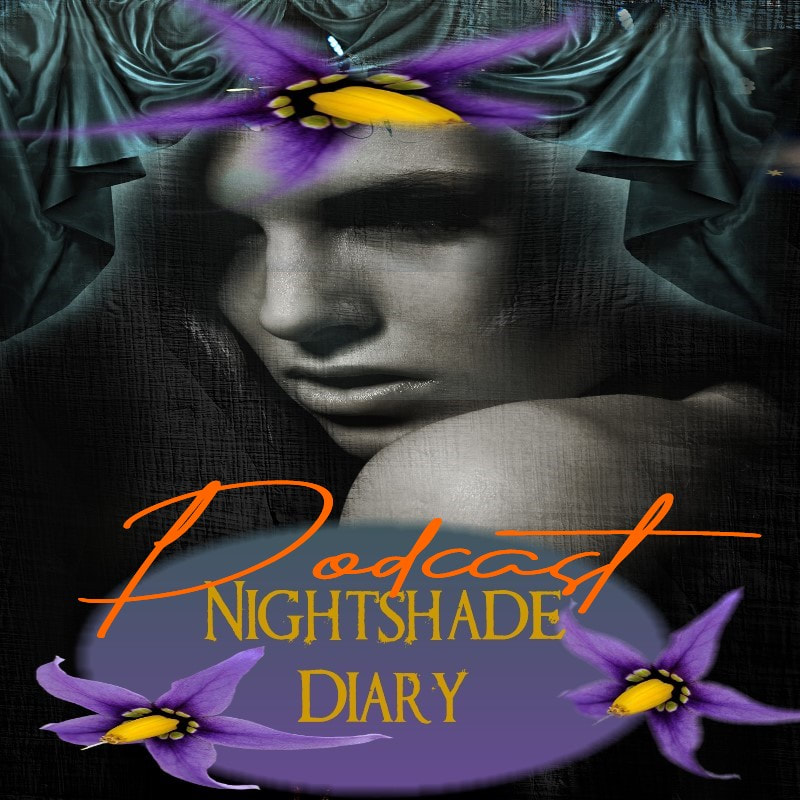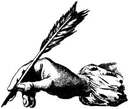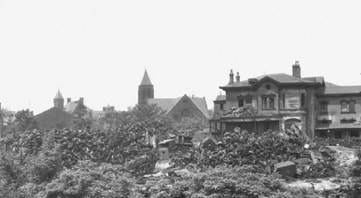 By M.P. Pellicer | Stranger Than Fiction Stories In the fall of 1923, a woman's savagely beaten body was found under the portico of the deserted Hussey Mansion at Center Avenue and Cypress Street, adjacent to the Homeopathic Hospital in Pittsburgh. Underneath her body was found an envelope with the "hand of death", consisting of the playing cards an ace, a deuce, a tray of diamonds and the five of spades. 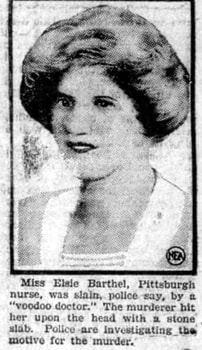 Elsie Barthel who was murdered in cold blood by Lorenzo Savage a so-called "voodoo doctor" c.1923 Elsie Barthel who was murdered in cold blood by Lorenzo Savage a so-called "voodoo doctor" c.1923 The woman's body was discovered by Alexander McGonigle when he was walking across the property. By then a nurse that lived at 4620 Carroll St. had been reported missing by her family. Her name was Elsie Barbara Barthel, 28, who according to her relatives planned to pay a certain self-proclaimed "voodoo doctor" for a love charm. The information was provided by Elsie's sister, Laura Barthel and John G. Kight, a brother-in-law. At the coroner's inquest it was revealed Elsie had died from fractures to her skull, and that she was pregnant. Known for her sterling reputation, perhaps it was these desperate circumstances that drove her to seek the help of Lorenzo Savage. Savage, 25, had once worked as a butler for Dr. R.S. Marhsall at his home office located at 424 Shady Ave. This is how they met, since Miss Barthel worked for the doctor as a nurse secretary for the past three years. By the time of the murder he had left the employ of Dr. Marshall, and he worked in the home of C.S. Mitchell on 327 South St., where both he and his wife Regina Taylor (aka Pearl Savage) were employed. Unfortunately for Savage, the police found one of his handkerchiefs close to the body. Also the fact that a conversation was overheard by her family, when he called asking for Elsie to meet him at a certain location for a love potion. The family was mystified since they thought that all was well between Elsie and her fiancée Walter Harry Haule (1895-1965). 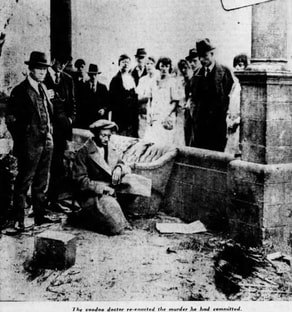 Savage reenacts the murder of Elsie Barthel c.1923 Savage reenacts the murder of Elsie Barthel c.1923 Elsie's death had been brutal. Her head was crushed, and beside her lay an envelope with the "bewitched cards". There was also an empty, blood-splattered envelope that had once contained money for "curing her love ills." Police traced Savage to a party he was attending with his wife. They were both arrested, but eventually his wife would be released. Police searched the room where they stayed, and found a deck of cards which were identical to the ones found with the body, and they were missing the ones left at the scene. The spell consisted of Savage giving her six cards held together by a black pin, and she was told the "charm" would work if she returned the cards to him, and paid him the money on the night she was killed. The police also held Walter Haule, Elsie Barthel's sweetheart when they found two of her handkerchiefs in his pocket and discrepancies on the stories he told, before and after Savage's arrest. Elsie and Walter had been involved for several years, and were slated to marry only a month later in November. Savage told police he took a ride in Haule's taxi from East Liberty to the Bedford Ave house where he lived, after leaving the scene of the crime. Police thought it was a strange coincidence that it was Haule who picked up Savage as a fare. Walter Haule had fainted when he was shown his fiancee's body at the morgue. Her burial was scheduled for October 10, 1923. When Walter Haule was brought into the station, he spied Savage which was already there. He pointed out this was the same man that that asked for a fare to the East End. When Savage saw Haule, he confessed to the murder, after maintaining his innocence up to that point. 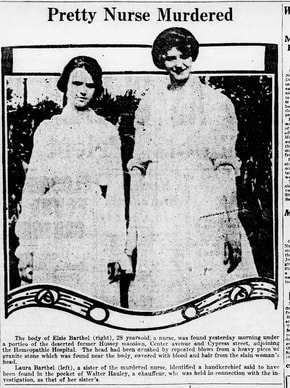 Elsie Barthel with her younger sister Laura (L) c.1920s Elsie Barthel with her younger sister Laura (L) c.1920s Within 24 hours after committing the crime, Savage returned to the mansion and reenacted the murder for the police. He said that Elsie had come to him and said she was having trouble in her love affairs. This is when he gave her the 6 cards. She was to perform certain rites over them, and return the cards to him on the assigned Saturday night with $395 (equivalent to $6,000 present day). Police were searching also for a certain "Will Rodgers", a mystery man in the case, since Savage declared the girl gave this name as that of the sweetheart responsible for her pregnancy. According to Savage resolution of the love triangle was the cure she was seeking. Police investigated if the ace, deuce, tray of diamonds and the five of spades was the hand of death. They consulted with a mystic named Eittella, known as the "dean of all fortune tellers", who said the original mark of death was the four aces of any suite. He clarified the ace of diamonds meant a letter or written notice of something about to happen. Other amateur fortune tellers said the deuce and tray of diamonds, meant a warning was sent regarding something about to happen, and any black card up to the 10 spot meant that something dark was about to occur in your life. This tended to bear out the police's theory that the cards clutched in Elsie's hand was a warning sent to her. Cards were used profusely in the southern part of the United States in the practice of the voodoo medicine doctors in the days before the Civil War, and were still used for those who believed in voodooism. Lorenzo Savage's family were from Virginia. Despite being a nurse, could Elsie have thought that a voodoo charm would relieve her of her pregnancy, which would mean her disgrace? Or perhaps she expected that the man who had made her pregnant would marry her after all. She knew her fiancée would not be happy to find that not only had she been with another man, but was pregnant with his child. Desperate situations make people believe the ridiculous. According to Savage, he struck Elsie in the face when she took the envelope with the money back, and she fell against the small wall along the side of the carriage entrance. As she fell he said she screamed: "I'll give it to you," but he picked up a brick and threw it at her head. She lay still after that and then he saw the large, heavy stone lying on the wall around the carriage entrance directly over the woman's head. He pushed the stone from the wall and it crushed her skull, causing her death. Once he made sure she was dead, he took the envelope with the money. He walked off the property, and when he reached Highland and Penn Avenues he hailed a cab. He opened the envelope and according to him, found it contained only $32 and not the $395 he expected. He didn't go home and instead spent $21 in the Hill district. The police said he blamed the victim for the crime, believing that if she had cooperated, nothing would have happened.  In the press, the murder of Elsie Barthel became known as the Voodoo Murder. c.1923 In the press, the murder of Elsie Barthel became known as the Voodoo Murder. c.1923 Police interviewed Minerva Rosaur a dietician at the Homepathic Hopsital, and William Mickler who escorted her home. She described where shortly after 11 p.m., an automobile containing three persons came up the driveway to the hospital, stopped a few minutes, and later backed into Center Avenue. A short time later the same auto, which had been parked on Center Ave, was again driven over the Hussey property and stopped under the portico of the mansion. They heard a piercing scream and then the cry, "don't do that." They saw no struggle, and a short time later the auto drove away. Savage came to trial in November, 1923 and pled not guilty. Frequently referred to as "Alonzo Savage" by the press, he was described as small in stature and he dressed in "sheikish" clothes with pearl buttons and bell-bottomed trousers, when he attended court. Despite his confession with a minute detail of using a 70 lb. piece of masonry to end the girl's life, he later recanted. He said Elsie Barthel was alive when he left the Hussey Mansion. Allegedly she told him she was waiting to meet her sweetheart there. He said the police had made him confess to the murder. The authorities denied it. During the trial Elsie's mother described that on October 3, her daughter had received a call. She was home because she was on vacation. She heard Elsie say she "would have 15 $1 bill and some pennies in an envelope." After she hung up, the mother asked who had called. She said it was Lorenzo. He called her again on October 6 and she left the house about 8:30 p.m. This was the last time her mother saw her alive. Mrs. Barthel then told of $400, most of which had been borrowed, were later found in Elsie's room on the floor. It seemed she had taken only about $30 when she left that night. Laura Barthel, Elsie sister testified she had given her sister the 15 $1 bills. 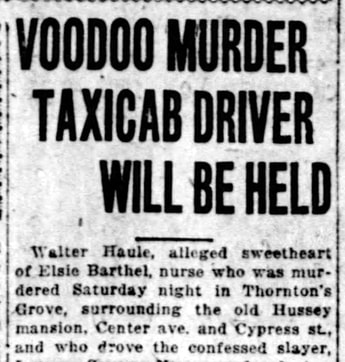 Ironically Walter Haule gave a taxicab ride to the man who had just killed his fiancee c.1923 Ironically Walter Haule gave a taxicab ride to the man who had just killed his fiancee c.1923 Under cross examination it was brought out that Savage was well acquainted with the Hussey Mansion, since he attended several dances there given by the Chauffeurs' Club. Then it was known as Thornton Grove, a well-known lover's lane that had taken over once the building was abandoned. Minerva Rosaur testified the Elsie Barthel's sweetheart was known as Rodgers, and that he worked at the Homestead Mills. She had seen him several times, but never spoken to him. During the trial Savage identified a young man in the courtroom as Rodgers, but according to the detectives his name was John R. Daugherty. Nothing ever came of this lead. Could Savage have been in cahoots with either Haule, the mysterious Mr. Daugherty or a third unknown party who had not expected he would kill the nurse, perhaps when she told him she had only brought $30 and not the windfall of $395? Perhaps the automobile Minerva Rosaur saw at the mansion was the parties returning to make sure Elsie Barthel was indeed dead. The wheels of justice turned quickly in those years, and by December, 1923, Savage had been convicted for the murder. Savage was executed on March 31, 1924 by electrocution. The body was not claimed and he was buried in the penitentiary's cemetery Walter Harry Haule, moved out to California and married a woman named Grace. He died in 1965 without any family around.
0 Comments
Your comment will be posted after it is approved.
Leave a Reply. |
Stranger Than Fiction StoriesM.P. PellicerAuthor, Narrator and Producer Archives
July 2024
Categories
All
|
Stories of the Supernatural
- Stories of the Supernatural
- Miami Ghost Chronicles
- M.P. Pellicer | Author
- Stranger Than Fiction Stories
- Eerie News
- Supernatural Storytime
-
Astrology Today
- Tarot
- Horoscope
- Zodiac
-
Haunted Places
- Animal Hauntings
- Belleview Biltmore Hotel
- Bobby Mackey's Honky Tonk
- Brookdale Lodge
- Chacachacare Island
- Coral Castle
- Drayton Hall Plantation
- Jonathan Dickinson State Park
- Kreischer Mansion
- Miami Biltmore Hotel
- Miami Forgotten Properties
- Myrtles Plantation
- Pinewood Cemetery
- Rolling Hills Asylum
- St. Ann's Retreat
- Stranahan Cromartie House
- The Devil Tree
- Trans-Allegheny Lunatic Asylum
- West Virginia Penitentiary
- Paranormal Podcasts
"When misguided public opinion honors what is despicable and despises what is honorable, punishes virtue and rewards vice, encourages what is harmful and discourages what is useful, applauds falsehood and smothers truth under indifference or insult, a nation turns its back on progress and can be restored only by the terrible lessons of catastrophe."
- Frederic Bastiat
- Frederic Bastiat

Copyright © 2009-2024 Eleventh Hour LLC. All Rights Reserved ®
DISCLAIMER
DISCLAIMER
 RSS Feed
RSS Feed


